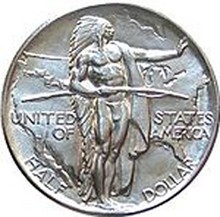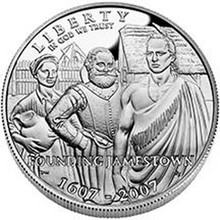 The U. S. Mint is honoring Native American figures, history, and culture with a special Native American Dollar Coin Program.
The U. S. Mint is honoring Native American figures, history, and culture with a special Native American Dollar Coin Program.
The program, which began in 2009, runs concurrently with the remainder of the Presidential dollar program.
The Native American Dollar Coin Program has sparked a lot of interest in Native Americans (or American Indians), as represented in the coin collecting world.
In fact, Native Americans and Native American culture have long been honored on United States coins.
See a list of Native American coins in circulation.
Here’s a guide to Native Americans featured on U.S. coins…
American Indians On Commemorative Coins
The U.S. Mint has struck a few commemorative coins over the past several decades which recognize and honor the role of American Indians (Native Americans) in our nation’s culture and history.
Here’s a list of commemorative American Indian coins which honor and recognize Native Americans:
The Arkansas Centennial half dollar, which was struck from 1935 through 1939, commemorates the 100th anniversary of Arkansas’ membership in the Union. On the reverse of the coin is a double profile of 2 figures: a European American woman clothed in the local fashion of 1936, and an American Indian chief representative of 1836. Arkansas Centennial half dollars are typically worth between $75 to $110.
The Daniel Boone Bicentennial half dollar, struck from 1934 through 1938, honors the famous American pioneer Daniel Boone. On the reverse of this half dollar is an image of Daniel Boone standing with Chief Black Fish. The Daniel Boone Bicentennial half dollar can be had for $110 to $125.
The Long Island Tercentenary half dollar, issued in 1936, celebrates the 300th anniversary of the European American settlement of Long Island. On the obverse of the coin are the profiles of a Dutch colonist and an American Indian. The Long Island Tercentenary can be purchased for $80 to $115.
The Missouri Centennial half dollar, struck in 1921, has an image of a frontiersman and an American Indian on the reverse. The coin sells for between $350 and $700 in typical grades.
The Oregon Trail Memorial half dollar was issued by the U.S. Mint from 1926 through 1939. The coin was struck to honor the many lives lost along the 2,000-mile trail. This half dollar was designed by James Earle Fraser (of Buffalo nickel fame) and his wife, Laura Gardin Fraser. On the reverse of the coin is a Native American (American Indian) man in feathered headdress standing proudly before a borderless map of the continental United States. The Oregon Trail half dollar is valued from $150 to $200 for higher-mintage dates.
The Providence Rhode Island Tercentenary half dollar was struck to commemorate the 300th anniversary of the founding of the New England city. The 1936 coin shows an image of Roger Williams being greeted by a Native American. This half dollar can be bought for $90 to $110.
The 2001 Buffalo “Indian Head” silver dollar is another recreation of James Earle Fraser’s 1913-1938 Buffalo nickel. This popular commemorative silver dollar can be had for $160 to $175.
 The 2007 Jamestown 400th Anniversary silver dollar marks the occasion of the founding of Jamestown, Virginia. This coin honors the historical town with an image of 3 figures which represent 3 groups of people who helped build early America:
The 2007 Jamestown 400th Anniversary silver dollar marks the occasion of the founding of Jamestown, Virginia. This coin honors the historical town with an image of 3 figures which represent 3 groups of people who helped build early America:
- European American settlers
- African American laborers
- Native Americans
The Jamestown 400th Anniversary silver dollar coin can be purchased for $35 to $40.
NOTE: The 2007 Jamestown 400th Anniversary $5 gold coin also features an American Indian.
Regarding commemorative coins featuring American Indians… it’s worth noting that the U.S. government has recognized over 150 Native American Indian Tribes who’ve been granted the tribal right of self-governance — with the ability to set their own priorities and goals for the welfare of their nations. One of these rights is the issuance of commemorative coins. These coins are not legal tender.
I’m the Coin Editor here at TheFunTimesGuide. My love for coins began when I was 11 years old. I primarily collect and study U.S. coins produced during the 20th century. I’m a member of the American Numismatic Association (ANA) and the Numismatic Literary Guild (NLG) and have won multiple awards from the NLG for my work as a coin journalist. I’m also the editor at the Florida United Numismatists Club (FUN Topics magazine), and author of Images of America: The United States Mint in Philadelphia (a book that explores the colorful history of the Philadelphia Mint). I’ve contributed hundreds of articles for various coin publications including COINage, The Numismatist, Numismatic News, Coin Dealer Newsletter, Coin Values, and CoinWeek. I’ve authored nearly 1,000 articles here at The Fun Times Guide to Coins (many of them with over 50K shares), and I welcome your coin questions in the comments below!

